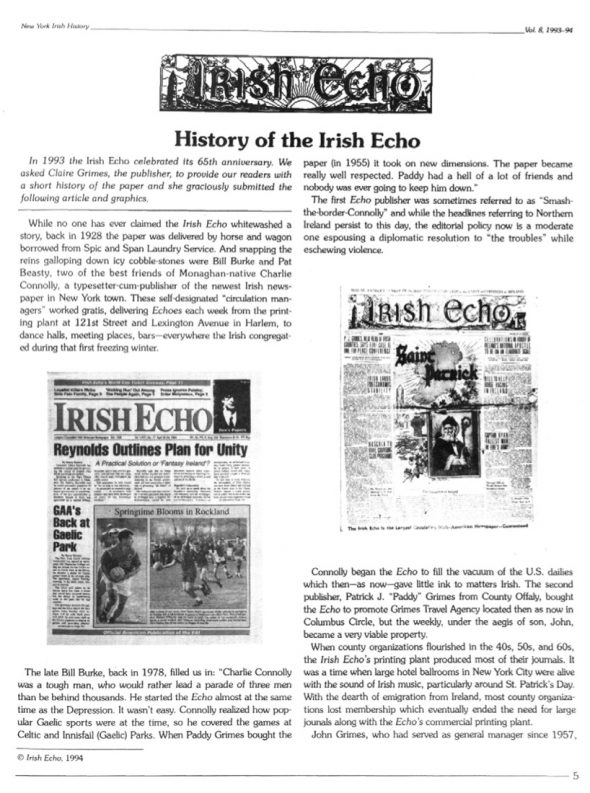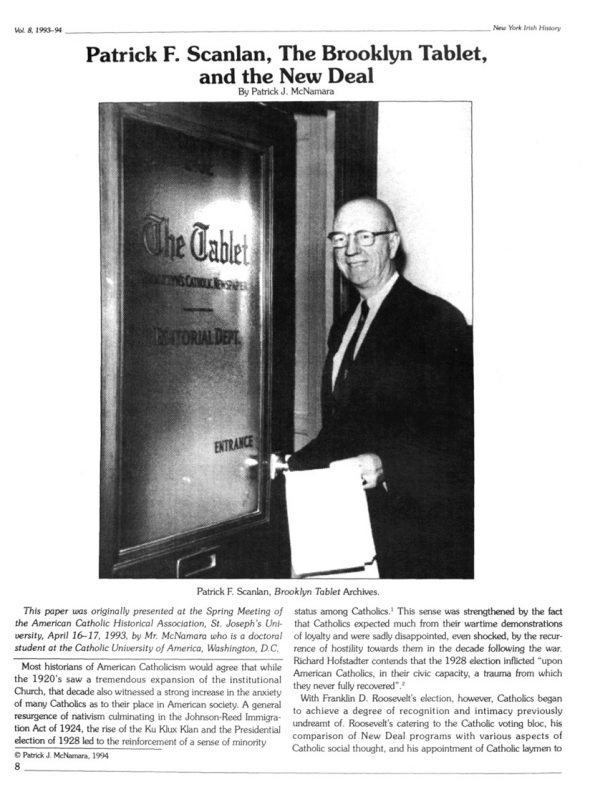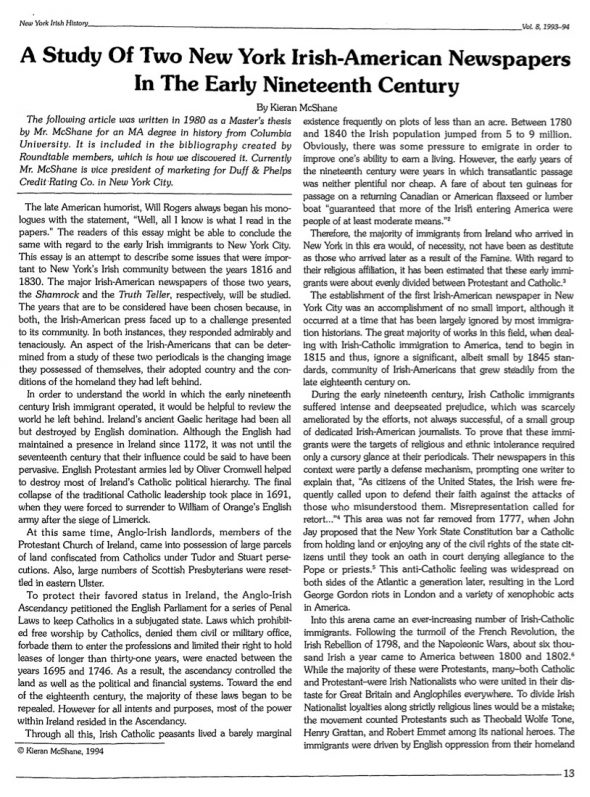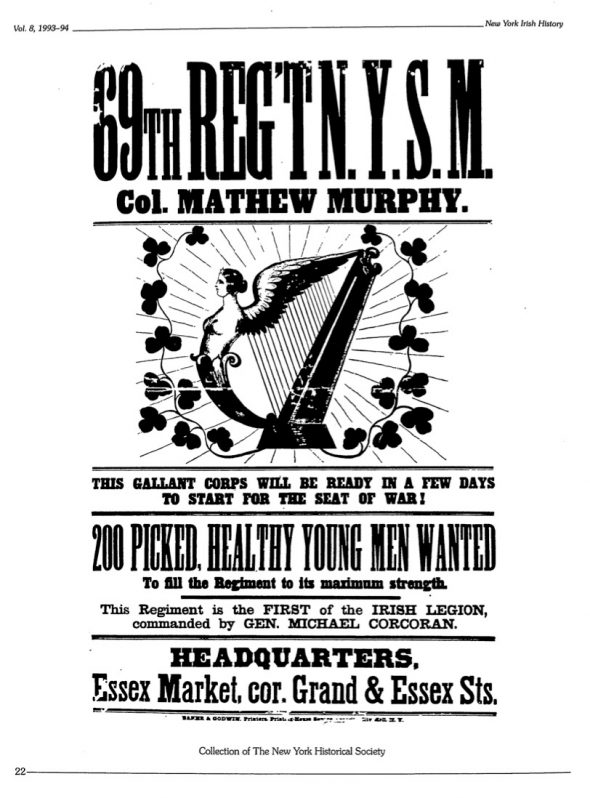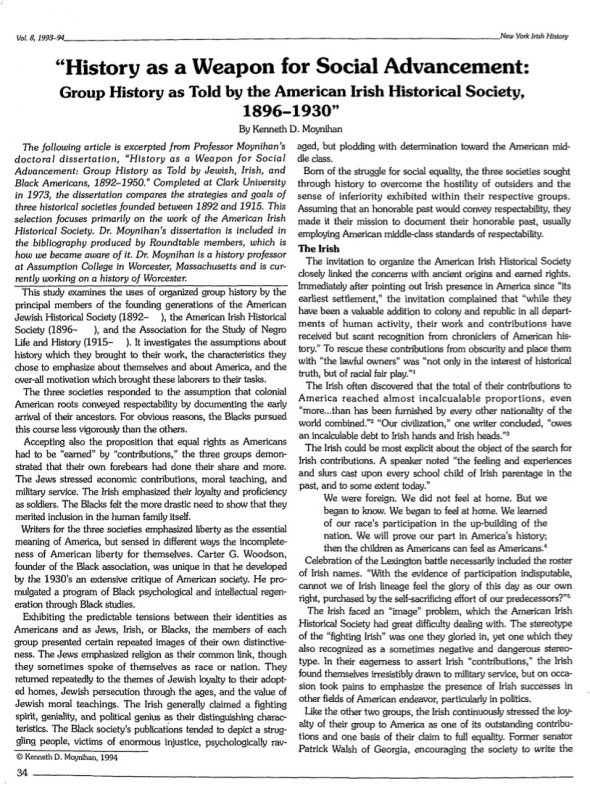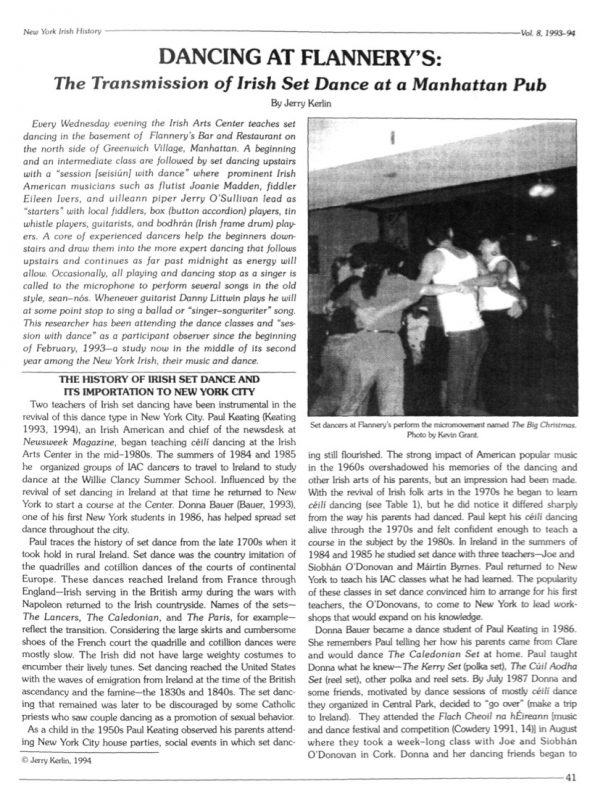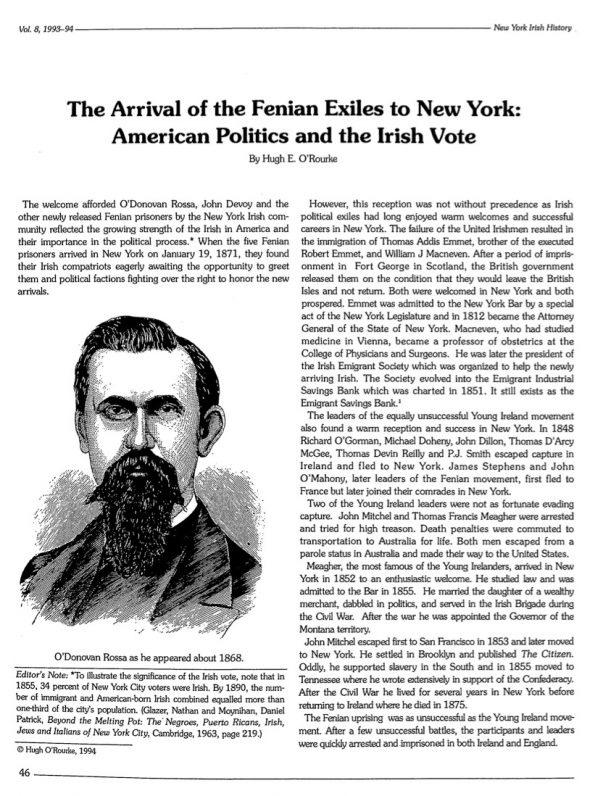New York Irish History Roundtable - Journal Articles
A Visit To St.Raymonds Cemetery, Bronx, NewYork 7 June 1992
Author: Marion Casey
Publication Year: 1993
Journal Volume: 07
Article Reference: NYIHR-V07-06
In January 1903, Patrick Parker purchased four graves in St. Raymond's Cemetery for $125. St. Raymond's opened in 1844 and is one of the largest parish cemeteries in the U.S. _23 Vol. 7, 1992-93. _New York Irish History Thomas Brennan was a native of Dublin and a member of the Irish Republican Brotherhood. He came to NYC following the Fenian uprising of 1867 and participated in the rescue of six Fenian prisoners from Freemantle, Australia by the Catalpa in 1876. NYIHR member Barney Kelly recounted a forgotten part of Fr. Francis P. Duffy's... [Read Full Article]
Crossing Highbridge
Author: Maureen Waters
Publication Year: 1993
Journal Volume: 07
Article Reference: NYIHR-V07-07
The following is an excerpt from a work in-progress memoir, Crossing Highbridge, about growing up in the Bronx.
The life of the neighborhood spilled out into the street. In our apartment house, which has vanished completely, windows were open and doors stood ajar. A continual coming and going eroded barriers between public and private space. Every one was familiar.
Families grew larger, four and five children were squeezed in together, but no one ever moved because the rent was good.
We were accustomed to a rattling hum... [Read Full Article]
The De La Salle Christian Brothers in New York, 1848-1914
Author: Philip M. Dowd, F.S.C.
Publication Year: 1993
Journal Volume: 07
Article Reference: NYIHR-V07-08
For the Irish people who were arriving in the United States the process of acculturation meant not only changing a way of life from a rural setting to an urban one but also from farming economy to a manufacturing or service economy. The need for different skills became apparent. Family who had preceded the newcomers, people from the same village, and the Church became the anchors and guides to this new life. The first immigrants found work as day laborers and in jobs that demanded a strong back rather than a good brain. These Irish men and... [Read Full Article]
History of the Irish Echo
Author: New York Irish History Roundtable
Publication Year: 1993-94
Journal Volume: 08
Article Reference: NYIHR-V08-01
While no one has ever claimed the Irish Echo whitewashed a story, back in 1928 the paper was delivered by horse and wagon borrowed from Spic and Span Laundry Service. And snapping the reins galloping down icy cobble-stones were Bill Burke and Pat Beasty, two of the best friends of Monaghan-native Charlie Connolly, a typesetter-cum-publisher of the newest Irish newspaper in New York town. These self-designated "circulation managers" worked gratis, delivering Echoes each week from the printing plant at 121st Street and Lexington Avenue in... [Read Full Article]
Patrick F. Scanlan, The Brooklyn Tablet, and the New Deal
Author: Patrick J. McNamara
Publication Year: 1993-94
Journal Volume: 08
Article Reference: NYIHR-V08-02
This paper was originally presented at the Spring Meeting of the American Catholic Historical Association, St. Joseph's University, April 16-17, 1993, by Mr. McNamara who is a doctoral student at the Catholic University of America, Washington, D.C. Most historians of American Catholicism would agree that while the 1920's saw a tremendous expansion of the institutional Church, that decade also witnessed a strong increase in the anxiety of many Catholics as to their place in American society. A general resurgence of nativism culminating in... [Read Full Article]
A Study Of Two New York Irish-American Newspapers In The Early Nineteenth Century
Author: Kieran McShane
Publication Year: 1993-94
Journal Volume: 08
Article Reference: NYIHR-V08-03
The late American humorist, Will Rogers always began his monologues with the statement, "Well, all I know is what I read in the papers." The readers of this essay might be able to conclude the same with regard to the early Irish immigrants to New York City.
This essay is an attempt to describe some issues that were important to New York's Irish community between the years 1816 and 1830. The major Irish-American newspapers of those two years, the Shamrock and the Truth Teller, respectively, will be studied.
The years that are... [Read Full Article]
War And Recruitment- Peasants As Patriots
Author: Marion A. Truslow
Publication Year: 1993-94
Journal Volume: 08
Article Reference: NYIHR-V08-04
The Civil War experience made the New York Irish Brigade recruits and their families (who received the Civil War Pension) Americans. In a slow process between 1850 and 1890, various institutions helped to bond immigrant Irish Catholic peasants to New York, then to the United States.
The workplace was the first institution connecting these Irish to the city, state, and nation. Builders of the New York State and eastern seaboard transportation network, the Irish transformed the infrastructure and were, in turn, transformed by it. They... [Read Full Article]
History as a Weapon for Social Advancement - Group History as Told by the American Irish Historical Society, 1896-1930
Author: Kenneth D. Moynihan
Publication Year: 1993-94
Journal Volume: 08
Article Reference: NYIHR-V08-05
This study examines the uses of organized group history by the principal members of the founding generations of the American Jewish Historical Society (1892- ), the American Irish Historical Society (1896- ), and the Association for the Study of Negro life and History (1915- ), It investigates the assumptions about history which they brought to their work, the characteristics they chose to emphasize about themselves and about America, and the over-all motivation which brought these laborers to their tasks.
The three societies... [Read Full Article]
Dancing At Flannerys - The Transmission of Irish Set Dance at a Manhattan Pub
Author: Jerry Kerlin
Publication Year: 1993-94
Journal Volume: 08
Article Reference: NYIHR-V08-06
Two teachers of Irish set dancing have been instrumental in the revival of this dance type in New York City. Paul Keating (Keating 1993, 1994), an Irish American and chief of the newsdesk at Newsweek Magazine, began teaching cei/f dancing at the Irish Arts Center in the mid-1980s. The summers of 1984 and 1985 he organized groups of IAC dancers to travel to Ireland to study dance at the Willie Clancy Summer School. Influenced by the revival of set dancing in Ireland at that time he returned to New York to start a course at the Center. Donna... [Read Full Article]
The Arrival of the Fenian Exiles to New York - American Politics and the Irish Vote
Author: Hugh E O'Rourke
Publication Year: 1993-94
Journal Volume: 08
Article Reference: NYIHR-V08-07
The welcome afforded O'Donovan Rossa, John Devoy and the other newly released Fenian prisoners by the New York Irish community reflected the growing strength of the Irish in America and their importance in the political process.- When the five Fenian prisoners arrived in New York on January 19, 1871, they found their Irish compatriots eagerly awaiting the opportunity to greet them and political factions fighting over the right to honor the new arrivals.
O'Donovan Rossa as he appeared about 1868. Editor's Note: -To... [Read Full Article]




